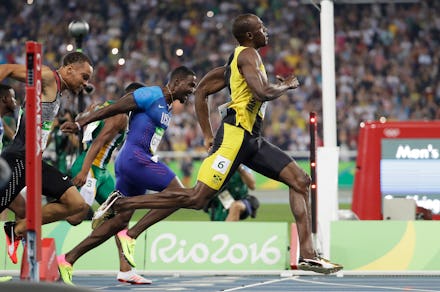Usain Bolt's Winning Race at the Rio Olympics, Explained by Science

Sprinter Usain Bolt of Jamaica just made history by winning his third straight gold medal in the men's 100-meter dash — something no runner has done before.
How does Bolt keep doing it?
Bolt doesn't win by moving his legs faster than everyone else. At the Olympic level, there are much more important factors that contribute to speed, and Bolt has figured out how to capitalize on them.
The mechanics of elite sprinting
The key to sprinting isn't a quicker stride, according to research by Peter Weyand, a professor of applied physiology and biomechanics at Southern Methodist University. It comes down to the amount of force a runner can apply to the ground, as well as how long they leave their feet on the ground per step.
Case in point: Studies have found the average runner applies about 500 to 600 pounds per step. An Olympic runner applies upward of 1,000 pounds. The average runner has their foot on the ground for 0.12 seconds per step, according to the Post Game. An Olympic runner has it there for less than a tenth of a second.
What gives Bolt that gold medal edge?
Bolt is really tall — he stands at 6 feet, 5 inches. Normally, that height would be a disadvantage, Weyand explained.
"Shorter individuals are advantaged coming out of the blocks and over the initial 5 to about 15 meters of the race," Weyand said in an email. "Shorter runners have less mass to move, so the ground force needed to accelerate the body is not as great. So although Bolt is not the best starter in the world, he loses relatively little ground versus what science indicates he should."
"Although Bolt is not the best starter in the world, he loses relatively little ground versus what science indicates he should."
After the start of the race, Bolt's height becomes a major advantage for two reasons, according to Weyand:
1. Faster top speed
Top sprinters usually hit the ground with a force about 4.5 to 5 times their body weight, Weyand explained. So even though he may not be as fast out of the gate, Bolt is larger, so he can hit the ground harder and reach a faster top speed.
"He travels further per step so for the same amount of mass-specific force on the ground, he travels a greater distance," Weyand said.
2. Harder to slow down
More massive things are harder to slow down, so Bolt doesn't exhibit the same kind of fatigue as his competitors.
"Bolt also should slow down less from his top racing speed because he takes fewer steps and therefore has fewer required cycles of applying ground force and activating leg muscles to do so," Weyand said.
That's also why Bolt seems to leave all the competition behind in the second half of every race.
"All runners slow down over the last 20 to 30 meters of a 100 meter race," Weyand said. "Bolt runs away from his competitors because his top-end speed is faster (reason 1 above) and because he is less susceptible to fatigue and losses in velocity than others who need to take more steps (reason 2 here)."
Bolt could be even faster
"His foot and ankle mechanics into the ground (which are crucial variable for force application and speed) seem excellent based on the available information, but could potentially be more forceful with modest adjustments," Weyand said.
Maybe we'll see Bolt in Tokyo in 2020?